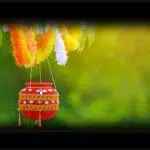Parsi New Year is celebrated on August 16 annually in India. This is a regional holiday in India, which marks the beginning of a new year according to the ‘Shahenshahi’ calendar. This calendar system is followed by the Indian Parsi community, mostly inhabiting the states of Gujarat and Maharashtra. The Parsi families all over the region, get together and visit their holy fire temples to offer prayers. The traditional Parsi cuisines such as farcha, jardaloo chicken, and berry pulav are prepared. Many Parsis start afresh on this day; they clean their houses, wash their clothes, make donations, and exchange presents.
History of Parsi New Year
The Parsi New Year, also known as Navroz or Nowroz, was named after Jamshed, an ancient Sassanian King. It is believed that he founded the Persian calendar or the Shahenshahi calendar. According to legend, he saved the world from a dangerous apocalypse. The myth states that he had a gemstone-embedded throne, rose to the heavens, and fought the demons. At that very moment, he shone as bright as the sun, hence the symbolism of the Parsi New Year’s new beginning for Persia.
Historically, the origin of the Parsi New Year was around 3,500 years ago as a part of their Zoroastrianism religion, which was founded by the Prophet Zarathustra in 650 to 600 B.C. in Persia, or today’s Iran. The celebration of this regional holiday has roots in the Zoroastrian philosophy, which believes in an annual renewal of all things in the universe. The day of celebration is based on the start of the ‘Fasli’ or ‘Bastnai’ calendar, marking the start of the annual Spring Equinox. This is a festival for the Zoroastrians not just in Iran, but also in other Middle Eastern countries where this religion is prominent. Until the emergence of Islam in the seventh century, Zoroastrianism was a prominent faith in the ancient world for a whole millennium.
After the Muslim conquest of Persia, a re-emergence of Nowruz was seen following the renaissance of the Iranian dynasties. In 1079 A.D. astronomer Omar Khayyam, along with a group of scholars, founded the ‘Jalali’ calendar that commenced from the day we call Nowruz. The Parsi New Year is still recognized as one of the most important faith-based events in the world today. In 2016, Nowruz was added to UNESCO’s list of Intangible Cultural Heritage of Humanity.
Parsi New Year timeline
The Prophet Zarathustra establishes Zoroastrianism, the religion linked to the celebration of the Parsi New Year.
The Arab-Muslim conquest sidelines Zoroastrianism as Islam takes the center stage.
Astronomer Khayyam establishes the Jalali calendar, which marks the start of the Parsi New Year.
Nowruz is added to UNESCO’s list of Intangible Cultural Heritage of Humanity.
Parsi New Year FAQs
Is Parsi New Year only celebrated in Iran?
The Parsi New Year is celebrated all over the world by Parsi-Zoroastrians. This annual celebration is not limited to Iran.
Who is the God of the Zoroastrians?
Ahura Mazdā is the God of the Zoroastrians.
What languages do Parsis speak?
Parsis speak Gujarati and English.
Parsi New Year Activities
Visit Agiary
On the day of Nowruz, the Parsis pay a visit to the ‘Agiary’ or commonly known as the fire temple. However, non-Parsis are not allowed. This is one of the most popular activities Parsi families do on August 16 to mark Nowruz.
Clean your house
As a symbolic day for new beginnings, there’s no better way to start anew than by cleaning your household. Grab this chance to do general cleaning in your house; you can wash clothes, sweep floors, and throw out unnecessary things.
Feast on traditional cuisine
What’s a festive new year without a delectable array of food? Start your year by cooking the most sumptuous Parsi cuisine. Make this day a bonding experience with your family in the kitchen. From egg pattice to Patra Ni Macchi, the list is endless!
5 Facts About Parsi New Year
It was originally celebrated on March 21
The celebration on August 16 is based on the Shahensahi Calendar, which does not account for leap years.
Parsis are a large group
There are about 0.2 million Zoroastrians around the world today.
The meaning of Nawruz
The term ‘Navroz’ or ‘Nowruz’ is a combination of two Persian words: ‘nav’ for ‘new’ and ‘roz’ for ‘day.’
Seven food delicacies
A part of their tradition is to serve food dishes that start with the sound of ‘sha’ or ‘sa’ symbolizing the creation of Earth in seven days.
Fire is their God
On this day, it’s a tradition for Parsis to keep a fire lit in a bowl of water to signify cleansing and bountiful wealth.
Why We Love Parsi New Year
It keeps the religion alive
According to the census, there has been a decline in the Parsi population in India. Celebrating Parsi New Year helps keep this religion alive. It’s a good way to introduce Zoroastrianism to the coming generations.
It’s a bonding event for families and friends
The Parsi New Year is the day to meet and greet your friends and family over prayers and sumptuous food. It’s a day to catch up, unwind, and celebrate.
We love new beginnings
Following an eventful year of highs and lows, the best way to move forward is by celebrating a fresh start. Parsi New Year is the main event to mark new beginnings by letting go of the past and looking forward to the year ahead.
Parsi New Year dates
| Year | Date | Day |
|---|---|---|
| 2025 | August 16 | Saturday |
| 2026 | August 16 | Sunday |
| 2027 | August 16 | Monday |
| 2028 | August 16 | Wednesday |
| 2029 | August 16 | Thursday |


















